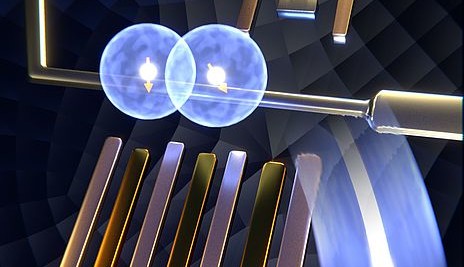A bucket brigade for single electrons
January 07, 2016
on
on

Researchers at TU Delft (Netherlands) have managed to transport individual electrons with a bucket brigade structure and read them out at the exit, all without altering the states of the electrons. This capability could be an important step in the development of future quantum computers.
In very simple terms, the spin of an electron can be regarded as the direction of rotation of the electron – either clockwise or counter-clockwise. The spin states of individual electrons can be used to store data, with each spin state corresponding to a binary value (0 or 1). Simultaneous spin transport of large numbers of electrons over relatively large distances has previously been achieved. Controlled transport of individual electrons through semiconductor materials is also a routine task now. However, nobody had previously succeeded in transporting individual electrons over large distances while maintaining their spin states.
To achieve this, the TU Delft researchers built a structure that works the same way as a charge-coupled device (CCD), but on a much smaller scale. In a CCD, packets of electrical charge are transported by a chain of capacitors. The charge packets arrive one by one at the end of the chain, where they are detected by an amplifier.
The TU Delft researchers developed a version of this concept dubbed “single-spin CCD.” It can shift electrons one by one along the chain without altering the spin of the electrons. The spin is read out at the end of the chain. In this case the chain consists of quantum dots, which are artificial atoms containing one electron each. As in a CCD, a series of three electrons is shifted step by step to the end of the chain by applying electric fields, and at the end of the chain they are read out by another quantum dot.
In very simple terms, the spin of an electron can be regarded as the direction of rotation of the electron – either clockwise or counter-clockwise. The spin states of individual electrons can be used to store data, with each spin state corresponding to a binary value (0 or 1). Simultaneous spin transport of large numbers of electrons over relatively large distances has previously been achieved. Controlled transport of individual electrons through semiconductor materials is also a routine task now. However, nobody had previously succeeded in transporting individual electrons over large distances while maintaining their spin states.
To achieve this, the TU Delft researchers built a structure that works the same way as a charge-coupled device (CCD), but on a much smaller scale. In a CCD, packets of electrical charge are transported by a chain of capacitors. The charge packets arrive one by one at the end of the chain, where they are detected by an amplifier.
The TU Delft researchers developed a version of this concept dubbed “single-spin CCD.” It can shift electrons one by one along the chain without altering the spin of the electrons. The spin is read out at the end of the chain. In this case the chain consists of quantum dots, which are artificial atoms containing one electron each. As in a CCD, a series of three electrons is shifted step by step to the end of the chain by applying electric fields, and at the end of the chain they are read out by another quantum dot.
Read full article
Hide full article


Discussion (0 comments)